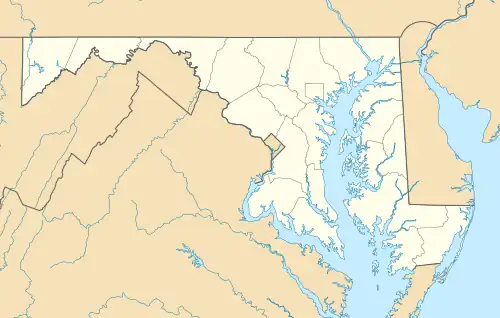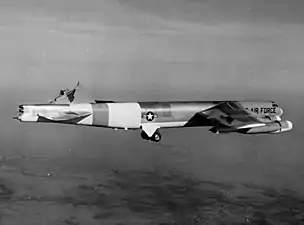.jpg.webp) A Boeing B-52D, similar to the accident aircraft | |
| Accident | |
|---|---|
| Date | 13 January 1964 |
| Summary | Structural failure |
| Site | Savage Mountain, Garrett County (near Frostburg, Maryland) 39°33′55″N 79°04′33″W / 39.565278°N 79.075833°W |
| Aircraft | |
| Aircraft type | Boeing B-52D Stratofortress |
| Operator | 484th Bombardment Wing, Heavy (SAC, United States Air Force) |
| Registration | 55-0060 (c/n 464012,[1] call sign "Buzz 14") |
| Flight origin | Westover Air Force Base |
| Destination | Turner Air Force Base
 Crash site Barton, MD Crash site in Maryland |
| Crew | 5: |
| Fatalities | 3 |
| Survivors | 2 (Pilot, copilot) |
The 1964 Savage Mountain B-52 crash was a U.S. military nuclear accident in which a Cold War bomber's vertical stabilizer broke off in winter storm turbulence.[3] The two nuclear bombs being ferried were found "relatively intact in the middle of the wreckage", according to a later U.S. Department of Defense summary,[4] and after Fort Meade's 28th Ordnance Detachment secured them,[5] the bombs were removed two days later to the Cumberland Municipal Airport.[6]
Accident description

The B-52D was returning to Georgia from Massachusetts after an earlier Chrome Dome airborne alert to Europe.[8] Near Meyersdale, Pennsylvania, on a path east of Salisbury, Pennsylvania;[9] and after altitude changes to evade severe turbulence;[4] the vertical stabilizer[8] broke off. The aircraft was left uncontrollable as a result; the pilot ordered the crew to bail out, and the aircraft crashed. The wreckage of the aircraft was found on the Stonewall Green farm.[9] Today, the crash site is in a private meadow of Elbow Mountain[10] within Savage River State Forest, along the public Savage Mountain Trail just north of the Pine Swamp Road crossing.[11]
While the official DOD description of the accident says that the two weapons "were relatively intact in the approximate center of the wreckage area," an account from William L. Stevens, a safety engineer at Sandia National Laboratories, says that "both bombs broke apart on impact." Stevens further said that an Explosive Ordnance Demolition team from the military was planning to remove the bombs quickly "to reduce media coverage", under the protest of Sandia engineers who felt it was unsafe to do so until the state of the bombs was fully known. The U.S. Atomic Energy Commission eventually developed a "carefully considered process" for removing the bomb pieces to an AEC facility.[12]
Later accounts by residents, and at least one local media accounts from the time, indicate that the bombs were removed from the site using construction equipment supplied from local businesses to the municipal airport.[13]
Crew
As the only crew member who did not eject, the radar bombardier[2] died in the crash and was not located until more than 24 hours afterward.[14] The navigator and tail gunner died of exposure in the snow. The navigator's frozen body was found two days[2] after the accident, 6 miles (10 km) from the crash and 3 miles (5 km) away[15] from where his orange parachute was found high in a tree near Poplar Lick Run.[9]: 1 Unable to disentangle his chute he released the Koch fittings and fell over thirty feet (9.1 m) through the tree, suffering injuries from the branches; his survival tent and other gear remained in the tree. He then attempted to find shelter and "meandered", eventually falling down a steep slope in the dark into a river basin.[2] After landing in the "Dye Factory field", the tail gunner trekked in the dark with a broken leg and other injuries[2] over 100 yards (90 m) to the embankment of Casselman River – in which his legs were frozen when his body was found five days later, 800 yards (700 m) from a Salisbury street light.[9]: 2, 4
The pilot parachuted onto Maryland's Meadow Mountain ridge near the Mason–Dixon line and, after being driven to the Tomlinson Inn on the National Road in Grantsville,[9]: 2 notified the United States Air Force of the crash. The co-pilot landed near New Germany Road, remained where he landed, and stayed "cozy warm" until rescued.[9]: 2
See also
References
- ↑ Baugher, Joseph F., "1955 USAF Serial Numbers", Encyclopedia of American Aircraft, archived from the original on 8 September 2009, retrieved 8 November 2009
- 1 2 3 4 5 Johnson, Richard Riley (1995). Twenty Five Milk Runs (And a few others): To Hell's Angels and back. Victoria, Canada: Trafford Publishing. pp. 261–2. ISBN 1-4120-2501-X.
- ↑ Sagan, Scott Douglas (1995). The Limits of Safety: Organizations, Accidents, and Nuclear Weapons. Princeton University Press. p. 202 (footnote 125). ISBN 0-691-02101-5.
- 1 2 "Narrative Summaries of Accidents Involving U.S. Nuclear Weapons: 1950–1980" (PDF). United States Department of Defense. Archived from the original (PDF) on 13 October 2014. Retrieved 18 October 2014.
- ↑ Dearth, Dan (10 November 2010). "Soldier secured nukes at B-52 crash in 1964". Herald News. Hagerstown, Maryland. Retrieved 19 October 2010.
- ↑ Whetzel, Dan (2002). "A Night to Remember" (PDF). Mountain Discoveries: 48–51. Retrieved 2 November 2009.
- ↑ Cenciotti, David (11 January 2021). "That Time A B-52H Stratofortress Bomber Lost Its Tail Over New Mexico But Managed To Land 6 Hours Later". The Aviationist. Retrieved 10 November 2023.
- 1 2 "Accident Description". AviationSafetyNetwork.net. Retrieved 16 November 2009.
- 1 2 3 4 5 6 Wood, David. "B-52 Crash". SalisburyPA.com: Newhouse News Service. Archived from the original on 30 November 2018. Retrieved 2 November 2009. (article + 5 pages of photos & clippings)
- ↑ "Crew Bails Out As Jet Crashes". Playground Daily News. Vol. 17, no. 244 (Morning ed.). Fort Walton Beach, Florida. United Press International. 14 January 1964. p. 1.
- ↑ Dreisbach, Mike (11 November 2009), "visitor information", Savage River Lodge (The "Savage River State Forest Trail Map Archived 18 December 2009 at the Wayback Machine" inaccurately names & depicts the "1962 B-52 Crash Site" as 1/6-mile on the incorrect (east) side of Westernport Road & 1/6-mile south of Swamp road.
- ↑ Stevens, William (2001). "The Origins and Evolution of S2C at Sandia National Laboratories: 1949 to 1996" (PDF). Sandia National Laboratories. Retrieved 6 August 2023.
- ↑ Shriver, Bucky (19 February 2021). "Buzz One Four & the Nuclear-armed B 52 Crash of 1964".
- ↑ "Secrecy Still Shrouds Plane Crash" (PDF). Utica Observer-Dispatch. 14 January 1964. Retrieved 26 November 2010.
- ↑ Beitler, Stu (6 August 2009). "Cumberland, MD (near) Bomber Crash, Jan 1964". Archived from the original on 2 March 2012. Retrieved 12 November 2009.
External links
- "Pilot Lands B-52 After Losing Tail". (Historic video of B-52H s/n 61-0023 landing without vertical stabilizer after test flight.) National Archives and Records Administration, archive id 2050727; local id 200-UN-37-19. 10 January 1965. MCA/Universal Pictures newsreel, hosted by Criticalpast.com.
- Buzz One Four – a documentary film about the incident by Matt McCormick.